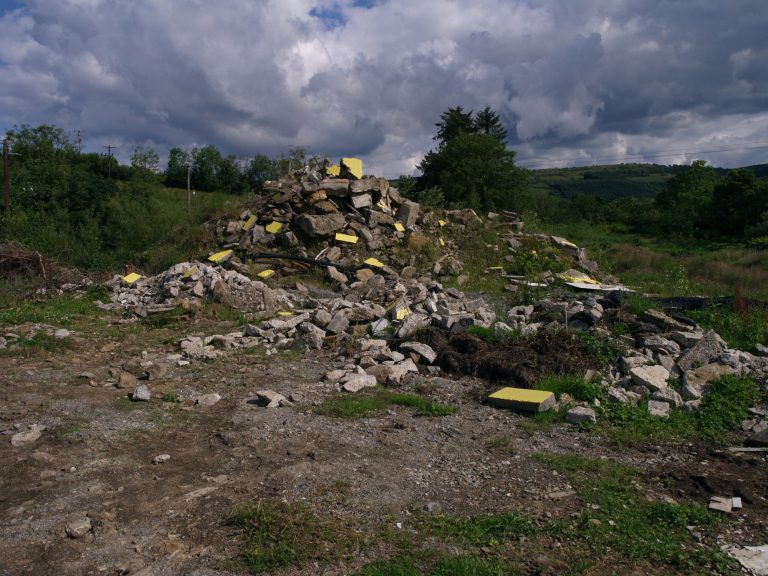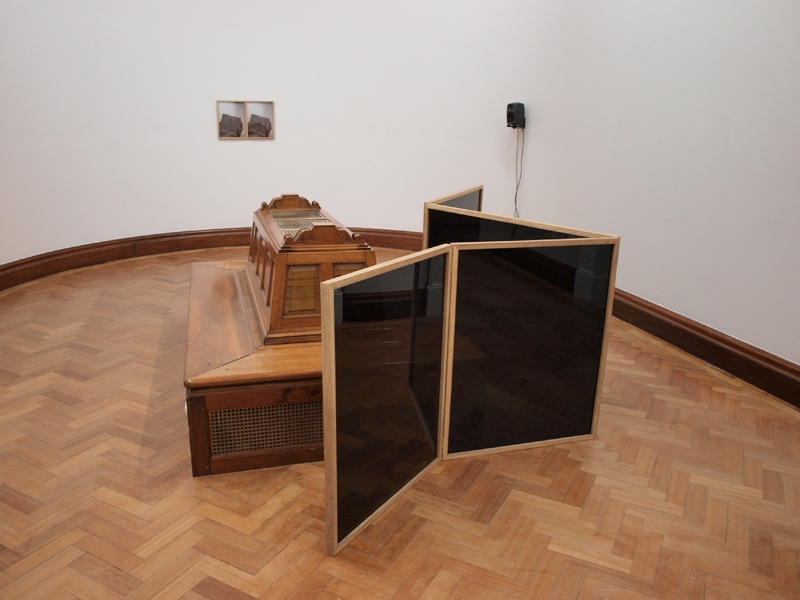Curated by Rowan Sexton.
Set in a small area of a contemporary design shop, Rupture is a show of recent work by Jennifer Hickey and Magnhild Opdøl. The works are softly lit from a centrally hanging light fixture. The caramel hue of the tightly-woven straw flooring and the dove grey walls harmonises the tawny creams and greys in the five works on show.
Pierced (2010) comprises a long swathe of layered white tulle suspended from the ceiling; small discs of porcelain have been sewn into a large circular form at its centre which is lit from behind creating a halo of light. There is an unexpected, enigmatic aspect to this dawning as the bottom edge of the circular form is broken and its sum parts cascade towards the floor.
Diagonal to Pierced, Hickey’s Untitled 2 (2011) has been installed in front of a floor-to-ceiling window. This piece reminded me of a mermaid’s fantastical bridal veil – the ‘veil’ is suspended from the ceiling where, at the apex, a cluster of porcelain and mother of pearl lustre pieces shimmer. The tulle trails along the straw floor as the studded white discs become larger and more dispersed in a flowing movement towards the end of the laced netting.
Opdøl’s work focuses on the animal kingdom and brings into sharp focus the beauty of death. In Narcissus (2011) a taxidermy life-size deer head is positioned diagonally on a square mirror in the small bay window. One glossy eye and a moist-looking nose point towards the centre of the room; upon closer inspection, the other eye is closed and reflected in the mirror beneath creating an interesting spatial play: the reflection representing both the eternally sleeping deer and the winking one full of life. Due to Natural Causes (2011) is an exquisite pencil drawing of a dead thrush. The bird hangs upside down, somehow suspended in the pristine white of the background and the shading creates a realistic representation of the thrush’s speckled breast and coloring of its feathers.
The tactile raw materials of both artists in this show are brought together in a kind of orbit by the lighting design which, although an item for sale in the shop, functions as a central axis around which the finished pieces are displayed. In “The Art of Light and Space”, American artist James Turrell uses light to carve space and time in one particular collaborative effort [1] and the use of light by both artist and curator in this exhibition also serves to sculpt space and time. The interplay between light and surfaces, both reflective and matt, and light and the artworks suggests an intimacy between the notions of rupture and fusion. The artists’ shared rigour, and sensibility for their raw materials is very much in evidence whether it is in the deft working of delicate porcelain and pearl or the sculpting of skin and fibers, particularly so in Narcissus.
These five works are complementary to the design aesthetic of the shop as many of the items for sale are chosen for their high quality, handcrafted features. One of the most salient parts of the curatorial strategy relates to the decision to exhibit in such an alternative space, one in which the works enter the realm of mass culture and shake hands with its ally conspicuous consumption.
The relationship between object, subject and space takes on new meaning in this retail setting and Brian O’Doherty’s seminal essay Inside the White Cube is particularly noteworthy in this regard. Kevin Hetherington, in his review article The Empty gallery?, offers a comprehensive explanation of one of the essay’s central arguments:
The white-cube gallery ideal, he (O’Doherty) suggests, establishes a space constituted outside of time in which we, as visiting subjects, can relate to art objects on display as pure forms outside of their everyday context.…Such a gallery type has this effect, O’Doherty believes, because the relationship between art (object) and viewer (subject) is one in which the eye of the viewer becomes detached from the embodied experience, leaving behind an empty form of spectatorship and spectatorial experience.[2]
The objective lies not in a quest to find alternative gallery spaces that would attempt to address any perceived shortcomings in the traditional gallery ideal but to explore the latent potentialities of “spatial elasticity”. In the case of Rupture one could argue that we are merely moving from one spectatorial experience to another; the store is brimming with contemporary design pieces all vying for customers’ attention and the artworks take their place alongside the art-like objects in this alternative ‘temple of art’. More interestingly this exhibition shows how context and not content becomes the catalysing force in the relationship between object and subject.
Caroline Usher lives in Dublin.
___________________________________________________________________________
[1] James Turrell, The Art of Light and Space, (Craig Adcock, 1990) p 151.
[2] Kevin Hetherington, Review Article The Empty gallery? Issues of subjects, objects and spaces: HYPERLINK www2.le.ac.uk/departments/museumstudies




